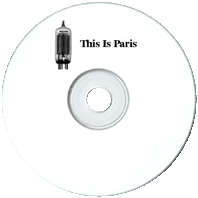

French Broadcasting System, the RTF or Radiodiffusion-Television Francaise, wanted to put together a program for American audiences to attract American tourist dollars and post-WWII sympathies

12 old time radio show recordings
(total playtime 5 hours, 19 min)
available in the following formats:
1 MP3 CD
or
6 Audio CDs
Text on OTRCAT.com ©2001-2025 OTRCAT INC All Rights Reserved. Reproduction is prohibited.
The War had ended. Sailors were kissing nurses in the middle of Times Square. America had grown up a good deal since the beginning of the decade and was poised on the edge of a period of an unprecedented postwar economic boom. The great cities of Europe were still trying to recover their former glory. American tourists, whose country had done so much to save those cities, were eager to capture some of the romance of the Old World.
The French Broadcasting System, the RTF or Radiodiffusion-Television Francaise, wanted to put together a program for American audiences. It was to be a program which would attract, if not American tourist dollars, at least American sympathies. That program would be the syndicated This Is Paris, also known as the Maurice Chevalier Show.

The first broadcast of the series is prefaced: "Our entire production company has been flown overseas from Hollywood". Of course, this was not the major undertaking that flying a motion picture production company would have been, as the show took advantage of local talent and facilities whenever possible.
The announcer was Jack Narz. Early in his career, Narz was one of the narrators for The Adventures of Superman. Later, he was notable as one of the hosts to come through the TV quiz show scandal with a good reputation. The house orchestra for This is Paris was led by Paul Baron. Although Baron was one of the lesser known names of the Big Band Era, he was one of the most successful. Rather than build a following in dancehalls and nightclubs, Baron kept his outfit in the studio where they played for some of the hottest singers of the era.
The centerpiece of This is Paris was showman Maurice Chevalier. Chevalier had been a popular singer and dancer on the Parisian circuit before the First World War. He was on the front lines during the Great War where he was injured and captured as a POW. He was eventually released through the intervention of King Alfonso XIII of Spain, who was a fan.
After the War, Chevalier discovered Jazz and began to consider a tour of the US. When Douglas Fairbanks was honeymooning in Paris with Mary Pickford, they tried to convince him to do movie work in Hollywood, but Maurice resisted, thinking he would not do well in silent pictures. After talkies became the rage, Paramount was eager to recruit him, and he went on to become one of the most recognized actors in Hollywood. In the late 1930s, he returned to Paris to perform in several revues. This is where he was when the Nazis entered Paris.
The Nazis tried to take advantage of Chevalier’s popularity by asking him to perform in Berlin and on the propaganda station Radio Paris. He refused, but he did agree to sing at the same POW camp where he had been interred during the First War. In exchange, ten prisoners were liberated. When Paris was liberated in 1944, Chevalier was accused of collaboration. He was acquitted by a French court, but the stain on his reputation made it difficult to obtain a visa. He also marched in a Parisian pro-Communist demonstration in 1944, so with the rise of McCarthyism he was effectively persona non grata in the US.
By 1954, McCarthyism had died down and Chevalier was again welcomed in America. He appeared in several films and on TV, taking advantage of his reputation as a "French Lover". His last film work was to provide the title tune for Walt Disney’s The Aristocats (1970). Maurice Chevalier passed away in Paris on New Year’s Day, 1972. He was 83.
A Star on the Hollywood Walk of Fame at 1651 Vine Street honors Maurice Chevalier’s contributions to Motion Pictures. The Star collocates with Stars honoring Alistair Cooke, Red Buttons, Eddie Bracken, Lionel Barrymore for Radio, Broncho Billy Anderson, Greer Garson, William Holden, and others.
For more French entertainment, see also: Paris Star Time and Maurice Chevalier.
Text on OTRCAT.com ©2001-2025 OTRCAT INC All Rights Reserved. Reproduction is prohibited.
You have reached the maximum number of votes for a unregistered user.
Please login or create a new account to continue...
You have reached the maximum number to down votes in this page.



This is Paris Disc A001
|
Add Audio CD to Cart - $5.00 |
This is Paris Disc A002
|
Add Audio CD to Cart - $5.00 |
This is Paris Disc A003
|
Add Audio CD to Cart - $5.00 |
This is Paris Disc A004
|
Add Audio CD to Cart - $5.00 |
This is Paris Disc A005
|
Add Audio CD to Cart - $5.00 |
This is Paris Disc A006
|
Add Audio CD to Cart - $5.00 |
Please wait...
COMMENTS
Be the first to comment on "This is Paris"
Leave a comment